Abstract
1. Activation of the sympathetic input to the urinary bladder by electrical stimulation of afferent fibres in the pelvic nerve evoked three responses: (1) an initial transient rise in intravesical pressure, (2) an inhibition of neurally evoked bladder contractions and (3) an inhibition of transmission in vesical parasympathetic ganglia. Similar responses were elicited by stimulation of the hypogastric nerve. 2. The reflex responses were observed in acute spinal preparations (T10-T12) and in cats with intact spinal cords, but were abolished by bilateral transection of the hypogastric nerves. 3. The inhibition of bladder contractions was antagonized by the administration of propranolol (200-400 mug, I.A.), a beta-adrenergic blocking agent. The inhibition of ganglionic transmission was antagonized by dihydroergotamine (30-75 mug, I.A.), an alpha-adrenergic blocking agent. The initial rise in intravesical pressure was not antagonized by either agent. 4. Electrical stimulation of other afferents (carotid sinus nerve and sciatic nerve) did not consistently elicit responses in the urinary bladder. However, stimulation of these afferents as well as pelvic nerve afferents evoked reflex firing in nerve filaments on the surface of the urinary bladder. The firing was abolished by transection of the ipsilateral hypogastric nerve. 5. It is concluded that stimulation of vesical afferents activates a spinal sympathetic reflex which results in closing of the internal urethral sphincter and a depression of bladder activity. The latter occurs by a direct depression of detrusor smooth muscle as well as a block of the neural input to the bladder. This vesico-sympathetic reflex represents a negative feed-back mechanism which may have an important role in the maintenance of urinary continence.
Full text
PDF














Selected References
These references are in PubMed. This may not be the complete list of references from this article.
- Caine M., Raz S. Some clinical implications of adrenergic receptors in the urinary tract. Arch Surg. 1975 Mar;110(3):247–250. doi: 10.1001/archsurg.1975.01360090017003. [DOI] [PubMed] [Google Scholar]
- De Groat W. C., Lalley P. M. Depression by p-methoxyphenylethylamine of sympathetic reflex firing elicited by electrical stimulation of the carotid sinus nerve or pelvic nerve. Brain Res. 1973 Dec 21;64:460–465. doi: 10.1016/0006-8993(73)90206-0. [DOI] [PubMed] [Google Scholar]
- De Groat W. C., Lalley P. M. Reflex firing in the lumbar sympathetic outflow to activation of vesical afferent fibres. J Physiol. 1972 Oct;226(2):289–309. doi: 10.1113/jphysiol.1972.sp009985. [DOI] [PMC free article] [PubMed] [Google Scholar]
- De Groat W. C. Nervous control of the urinary bladder of the cat. Brain Res. 1975 Apr 11;87(2-3):201–211. doi: 10.1016/0006-8993(75)90417-5. [DOI] [PubMed] [Google Scholar]
- De Groat W. C., Saum W. R. Sympathetic inhibition of the urinary bladder and of pelvic ganglionic transmission in the cat. J Physiol. 1972 Jan;220(2):297–314. doi: 10.1113/jphysiol.1972.sp009708. [DOI] [PMC free article] [PubMed] [Google Scholar]
- Edvardsen P. Nervous control of urinary bladder in cats. I. The collecting phase. Acta Physiol Scand. 1968 Jan-Feb;72(1):157–171. doi: 10.1111/j.1748-1716.1968.tb03838.x. [DOI] [PubMed] [Google Scholar]
- Gjone R. Peripheral autonomic influence on the motility of the urinary bladder in the cat. I. Rhythmic contractions. Acta Physiol Scand. 1965 Dec;65(4):370–377. doi: 10.1111/j.1748-1716.1965.tb04287.x. [DOI] [PubMed] [Google Scholar]
- KURU M. NERVOUS CONTROL OF MICTURITION. Physiol Rev. 1965 Jul;45:425–494. doi: 10.1152/physrev.1965.45.3.425. [DOI] [PubMed] [Google Scholar]
- Krane R. J., Olsson C. A. Phenoxybenzamine in neurogenic bladder dysfunction. I. A theory of micturition. J Urol. 1973 Dec;110(6):650–652. doi: 10.1016/s0022-5347(17)60305-7. [DOI] [PubMed] [Google Scholar]
- Krane R. J., Olsson C. A. Phenoxybenzamine in neurogenic bladder dysfunction. II. Clinical considerations. J Urol. 1973 Dec;110(6):653–656. doi: 10.1016/s0022-5347(17)60306-9. [DOI] [PubMed] [Google Scholar]
- RETIEF P. J. M. Physiology of micturition and ejaculation. S Afr Med J. 1950 Jul 1;24(26):509–512. [PubMed] [Google Scholar]
- Saum W. R., De Groat W. C. Parasympathetic ganglia: activation of an adrenergic inhibitory mechanism by cholinomimetic agents. Science. 1972 Feb 11;175(4022):659–661. doi: 10.1126/science.175.4022.659. [DOI] [PubMed] [Google Scholar]
- Saum W. R., Groat W. C. Antagonism by bulbocapnine of adrenergic inhibition in parasympathetic ganglia in the urinary bladder. Brain Res. 1972 Feb 25;37(2):340–344. doi: 10.1016/0006-8993(72)90682-8. [DOI] [PubMed] [Google Scholar]
- de Groat W. C., Lalley P. M. Reflex sympathetic firing in response to electrical stimulation of the carotid sinus nerve in the cat. Brain Res. 1974 Nov 8;80(1):17–40. doi: 10.1016/0006-8993(74)90721-5. [DOI] [PubMed] [Google Scholar]
- de Groat W. C., Ryall R. W. Reflexes to sacral parasympathetic neurones concerned with micturition in the cat. J Physiol. 1969 Jan;200(1):87–108. doi: 10.1113/jphysiol.1969.sp008683. [DOI] [PMC free article] [PubMed] [Google Scholar]


